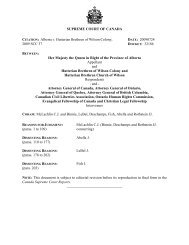Canada (Attorney General) v. Bedford, 2012 ONCA ... - York University
Canada (Attorney General) v. Bedford, 2012 ONCA ... - York University
Canada (Attorney General) v. Bedford, 2012 ONCA ... - York University
You also want an ePaper? Increase the reach of your titles
YUMPU automatically turns print PDFs into web optimized ePapers that Google loves.
Page: 129exacerbate the claimant‟s already vulnerable position (as in PHS), then theimpact would likely be found to be extreme. On the other hand, if the law is onlyone of a number of factors that contributes to the s. 7 deprivation, it does notnecessarily follow that the impact is extreme, even where the claimant is highlyvulnerable.[320] So it is with the communicating provision. It is clear that street prostitutes,and particularly survival sex workers, face tremendous disadvantage. It is alsoclear that the communicating provision prevents street prostitutes from speakingto prospective customers before deciding whether or not to take a job. What isless clear, however, is the degree to which this prohibition actually causes orcontributes to the harm this group experiences.[321] The evidence suggests – and the submissions of many of the intervenersreinforce – that poverty, addiction, gender, race and age are the primary sourcesof survival sex workers‟ marginalization. With that marginalization comes muchof the risk associated with street prostitution. For the reasons we have given, weare not persuaded that the communicating provision is a dominant, or even asignificant, factor among the many social, economic, personal and culturalfactors that combine to place survival sex workers at significant risk on the street.[322] This is not to say that the communicating provision does not contribute tosome degree of harm. As we have explained, we are satisfied that it has enough
















